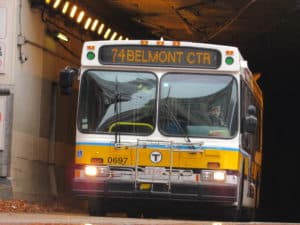Several suburban Boston communities’ experiments with improving MBTA bus routes have succeeded, according to a new report from The Barr Foundation, speeding up trips significantly and making the buses more reliable.
“I’m pleased to see the data confirms what our customers are saying: that these improvements directly results in better performance and greater reliability of our bus routes,” MBTA General Manager Steve Poftak said in a statement. “Forming these partnerships with cities and towns, with support from BostonBRT, is a key element in our strategy to deliver improved service. I want to thank the communities we serve for their leadership on this issue, and I look forward to expanding our growing network of bus infrastructure improvements.”
Three pilot projects in Arlington, Cambridge, Watertown and Everett tested items like dedicated bus lanes and subway-like “level boarding” platforms for several key bus routes in each community in 2018. The projects were coordinated through the BostonBRT initiative, funded by The Barr Foundation and managed by the Institute for Transportation & Development Policy, with additional technical support from Stantec.
Transit activists hope making buses across Greater Boston faster and more reliable will induce more drivers to leave their cars at home. Public transit leaders see promise in spreading the improvements further, too: MBTA Fiscal Management and Control Board chair Joseph Aiello suggested late last month that the transit authority should work more aggressively to help municipalities speed up bus routes. Most bus improvements like dedicated lanes require towns and cities to take action, as they control most roads, sidewalks and traffic signals.
Bus riders in Arlington saved up to 10 minutes on their commute thanks to a dedicated bus lane that replaced parking spaces on Massachusetts Avenue during rush hour and lengthened green lights when buses were approaching, according to The Barr Foundation. Riders’ median trips through the Arlington pilot area were 41 percent faster between 7 a.m. and 8 a.m. and 53 percent faster between 8 a.m. and 9 a.m. compared with regular service. Cambridge and Watertown bus riders saved around five minutes on an average trip to Harvard Square during morning rush hour using shorter lanes along Mt. Auburn Street that let them jump ahead of cars backed up at red lights. Surveys of Cambridge and Watertown riders showed that the time savings felt even more significant to riders, with more than half reporting they saved between seven and 10 minutes.
During peak hours, buses traveling in the direction of peak traffic operated far more reliably, with 64 percent less variance from their scheduled times in Arlington and approximately 69 percent less variance in Cambridge and Watertown.
In Arlington, 67 percent of survey respondents reported satisfaction with the dedicated bus lane pilot. More than 70 percent of Arlington survey respondents indicated support for the bus lanes being made permanent, with 58 percent of respondents expressing that the bus lanes should be extended. In Cambridge and Watertown, more than half of survey respondents indicated satisfaction with their commute during the pilot, compared with 19 percent who indicated satisfaction prior to implementation.
Arlington, Cambridge and Watertown plan to keep the experiments’ improvements in operation on a permanent basis, The Barr Foundation reported.




 |
| 


